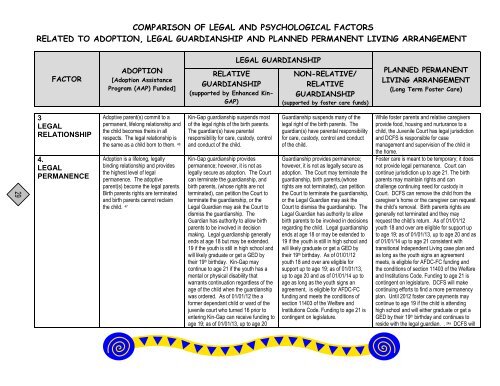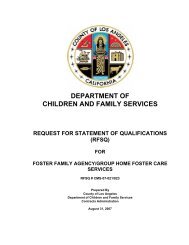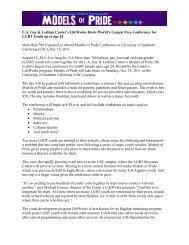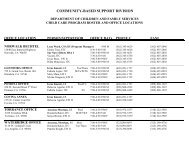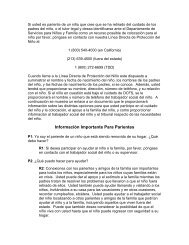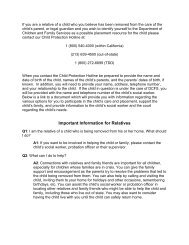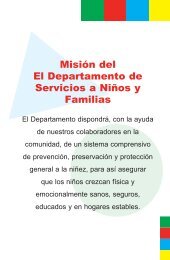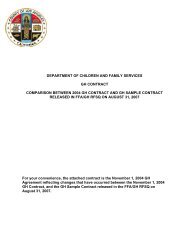Permanency Guide - Los Angeles County Department of Children ...
Permanency Guide - Los Angeles County Department of Children ...
Permanency Guide - Los Angeles County Department of Children ...
Create successful ePaper yourself
Turn your PDF publications into a flip-book with our unique Google optimized e-Paper software.
COMPARISON OF LEGAL AND PSYCHOLOGICAL FACTORS<br />
RELATED TO ADOPTION, LEGAL GUARDIANSHIP AND PLANNED PERMANENT LIVING ARRANGEMENT<br />
FACTOR<br />
3<br />
LEGAL<br />
RELATIONSHIP<br />
4.<br />
LEGAL<br />
PERMANENCE<br />
ADOPTION<br />
[Adoption Assistance<br />
Program (AAP) Funded]<br />
Adoptive parent(s) commit to a<br />
permanent, lifelong relationship and<br />
the child becomes theirs in all<br />
respects. The legal relationship is<br />
the same as a child born to them. 46<br />
Adoption is a lifelong, legally<br />
binding relationship and provides<br />
the highest level <strong>of</strong> legal<br />
permanence. The adoptive<br />
parent(s) become the legal parents.<br />
Birth parents rights are terminated<br />
and birth parents cannot reclaim<br />
the child. 47<br />
RELATIVE<br />
GUARDIANSHIP<br />
(supported by Enhanced Kin-<br />
GAP)<br />
Kin-Gap guardianship suspends most<br />
<strong>of</strong> the legal rights <strong>of</strong> the birth parents.<br />
The guardian(s) have parental<br />
responsibility for care, custody, control<br />
and conduct <strong>of</strong> the child.<br />
Kin-Gap guardianship provides<br />
permanence; however, it is not as<br />
legally secure as adoption. The Court<br />
can terminate the guardianship, and<br />
birth parents, (whose rights are not<br />
terminated), can petition the Court to<br />
terminate the guardianship, or the<br />
Legal Guardian may ask the Court to<br />
dismiss the guardianship. The<br />
Guardian has authority to allow birth<br />
parents to be involved in decision<br />
making. Legal guardianship generally<br />
ends at age 18 but may be extended.<br />
19 if the youth is still in high school and<br />
will likely graduate or get a GED by<br />
their 19 th birthday. Kin-Gap may<br />
continue to age 21 if the youth has a<br />
mental or physical disability that<br />
warrants continuation regardless <strong>of</strong> the<br />
age <strong>of</strong> the child when the guardianship<br />
was ordered. As <strong>of</strong> 01/01/12 the a<br />
former dependant child or ward <strong>of</strong> the<br />
juvenile court who turned 16 prior to<br />
entering Kin-Gap can receive funding to<br />
age 19; as <strong>of</strong> 01/01/13, up to age 20<br />
LEGAL GUARDIANSHIP<br />
NON-RELATIVE/<br />
RELATIVE<br />
GUARDIANSHIP<br />
(supported by foster care funds)<br />
Guardianship suspends many <strong>of</strong> the<br />
legal right <strong>of</strong> the birth parents. The<br />
guardian(s) have parental responsibility<br />
for care, custody, control and conduct<br />
<strong>of</strong> the child.<br />
Guardianship provides permanence;<br />
however, it is not as legally secure as<br />
adoption. The Court may terminate the<br />
guardianship, birth parents,(whose<br />
rights are not terminated), can petition<br />
the Court to terminate the guardianship,<br />
or the Legal Guardian may ask the<br />
Court to dismiss the guardianship. The<br />
Legal Guardian has authority to allow<br />
birth parents to be involved in decisions<br />
regarding the child. Legal guardianship<br />
ends at age 18 or may be extended to<br />
19 if the youth is still in high school and<br />
will likely graduate or get a GED by<br />
their 19 th birthday. As <strong>of</strong> 01/01/12<br />
youth 18 and over are eligible for<br />
support up to age 19; as <strong>of</strong> 01/01/13,<br />
up to age 20 and as <strong>of</strong> 01/01/14 up to<br />
age as long as the youth signs an<br />
agreement, is eligible for AFDC-FC<br />
funding and meets the conditions <strong>of</strong><br />
section 11403 <strong>of</strong> the Welfare and<br />
Institutions Code. Funding to age 21 is<br />
contingent on legislature.<br />
PLANNED PERMANENT<br />
LIVING ARRANGEMENT<br />
(Long Term Foster Care)<br />
While foster parents and relative caregivers<br />
provide food, housing and nurturance to a<br />
child, the Juvenile Court has legal jurisdiction<br />
and DCFS is responsible for case<br />
management and supervision <strong>of</strong> the child in<br />
the home.<br />
Foster care is meant to be temporary; it does<br />
not provide legal permanence. Court can<br />
continue jurisdiction up to age 21. The birth<br />
parents may maintain rights and can<br />
challenge continuing need for custody in<br />
Court. DCFS can remove the child from the<br />
caregiver’s home or the caregiver can request<br />
the child’s removal. Birth parents rights are<br />
generally not terminated and they may<br />
request the child’s return. As <strong>of</strong> 01/01/12<br />
youth 18 and over are eligible for support up<br />
to age 19; as <strong>of</strong> 01/01/13, up to age 20 and as<br />
<strong>of</strong> 01/01/14 up to age 21 consistent with<br />
transitional Independent Living case plan and<br />
as long as the youth signs an agreement<br />
meets, is eligible for AFDC-FC funding and<br />
the conditions <strong>of</strong> section 11403 <strong>of</strong> the Welfare<br />
and Institutions Code. Funding to age 21 is<br />
contingent on legislature. DCFS will make<br />
continuing efforts to find a more permanency<br />
plan. Until 2012 foster care payments may<br />
continue to age 19 if the child is attending<br />
high school and will either graduate or get a<br />
GED by their 19 th birthday and continues to<br />
reside with the legal guardian. . 24a DCFS will


